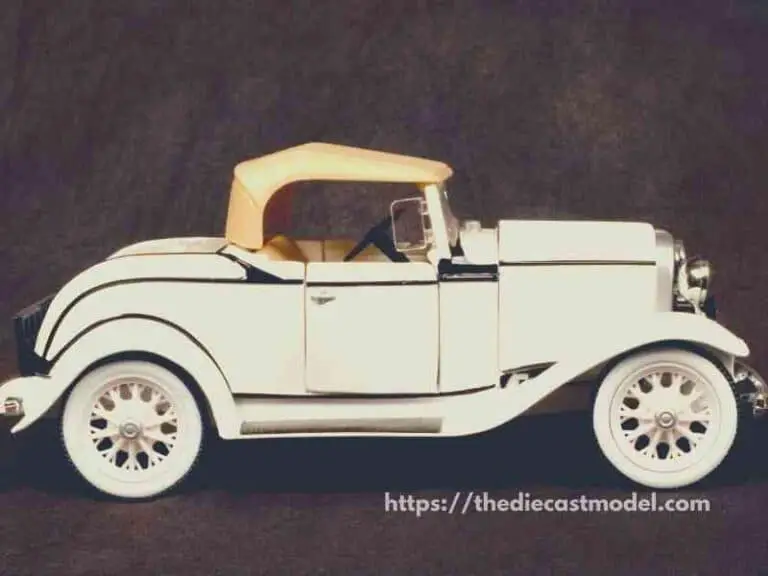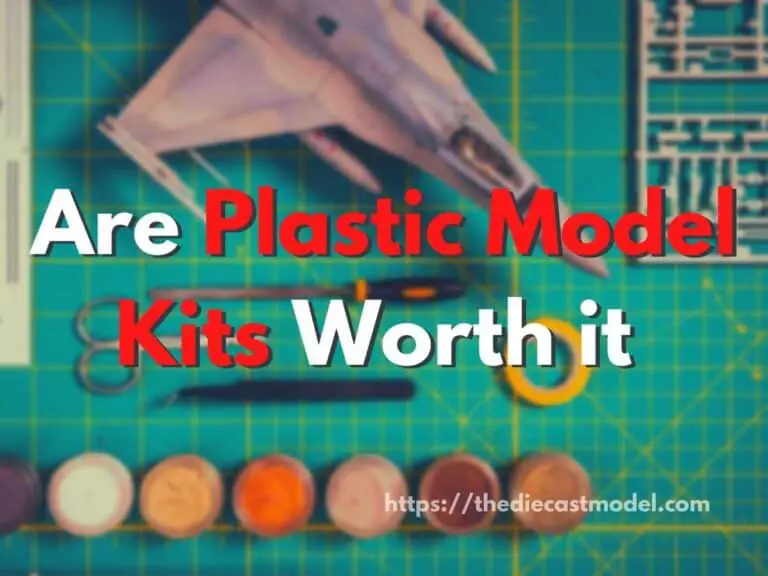Are Diecast Toys Safe? A Guide for Collectors and Parents
Lead poisoning is a fatal threat to young children. According to the Centers for Disease Control, more than half a million children aged one to five in the US have blood lead levels high enough to harm their health. Even with treatment, lead poisoning can have a long-term impact on a child’s development. Babies and young children are most vulnerable because their bodies are small and growing.
Diecast toys are safe since they are now made of aluminum, magnesium, and zinc alloy, also known as Zamak. Lead in diecast toys has been rare due to the stricter regulations in the 70s. However, these toys might still be toxic if swallowed.
As a result, parents are concerned about their children’s toys, specifically the diecast model toy cars. There are also some collectors having the same questions.

Is a diecast toy safe?
The standards for children’s toys and paint were implemented in the United States in the 1970s and were only recently revised.
Collectors undoubtedly value older toys, but because toy conditions can change over time, safety standards change and are revised over time.
Mattel, Hot Wheel’s manufacturer, does not recommend that younger children play with older toys.
You can take it ahead and have the cars tested.
Some non-profit safety organizations provide x-ray fluorescence testing. You can also pay a private lab to test a sample of the cars if you have the money and the time.
However, the cost of testing will most likely far exceed the value of each car.
That’s the reason I made this blog post.
I want to give you some insights into my research and, of course, to save you some money in testing.
So, let’s start with some points I got from my research.
On her blog, Debra Lynn Dadd discusses toxic-free products and suggests that every company must display its manufacturing process, including toxin information.
She noted that toy products frequently include statements such as “paint contains no heavy metals” and other statements indicating an awareness of where toxins are present in the materials.
That’s why the easiest way to find out if these models are safe is to check the label.
Because of stricter regulations, manufacturers are obliged to put these labels on their products.
But to know more about the topic, we need to discuss more about making these models. The process is known as diecasting.
Do diecast toys contain lead?
Recently, diecast toys do not contain lead, thanks to strict safety regulations on the matter. Furthermore, a test on 28 samples ranging from the 1960s to the 2010s is examined for lead using Energy Dispersive Spectroscopy found no lead on these toys, proving that stricter regulations are working.
Previously, diecasting metal was made of lead alloy.
As the safety standards changed over time, diecast metal is now made of Zamak, called Mazak in the UK, an alloy of zinc with trace amounts of aluminum and copper.
Zinc, like aluminum, is a commonly used metal in die casting.
Zinc is frequently used in the production of casting products for the automotive and medical supply industries.
Zinc needs less energy to produce due to its low melting point.
The low melting point also helps mold life, which is essential in the value of die casting in medical equipment and model toys.
Zinc has excellent corrosion resistance and high thermal conductivity.
As a result, this material is highly durable, rigid, and stable.
When it comes to aesthetic customization, zinc castings are usually the best option. That is why Zamak is widely used for diecast model toy cars.
This is also why I made the point in another blog post that diecast models don’t rust. This is because diecast models are made of Zamak, while rust comes from Iron. However, it is still prone to oxidation which is the greenish-white substance you’ll see in an old model. If you want some safety tips to prevent this, you may check this blog post: How to prevent diecast oxidation.
On the other hand, Dr. Shangshang Mu, Application engineer of EDAX and an avid diecast toy car collector, researched diecast model toy cars to determine if they contain any toxic elements.
He got 28 samples ranging from the 1960s to the 2010s to examine.
They mainly were Matchbox, but some were also from other popular toy car brands in the United States.
As an Applications Engineer at EDAX, Dr. Mu had several material characterization techniques to choose from, such as The Orbis Micro-XRF Analyzer that can perform non-destructive elemental analysis on a wide range of sample types and shapes.
So, he could put the toy cars directly into the analyzer to get the results.
But, it was in the middle of testing new features, so he chose Energy Dispersive Spectroscopy (EDS) to test the new Batch Mode feature.
He loaded all paint samples into the SEM chamber and ran them all at once using an Octane Elite Silicon Drift Detector.
Fortunately, the results show that none of the samples he tested contained lead.
The colors of the paint samples were correlated to the identified characteristic peaks; titanium dioxide and zinc oxide were white, carbon was black, and sulfur-containing sodium silicate was blue.
For more information regarding the diecasting process and Zamak, feel free to check my other blog post about the process in more detailedly. Here is the link for that post: What are diecast models made of?
How can I test my toys for lead?
There are many simple tests for toys to find if it has lead such as checking if the product is made from a reputable manufacturer, checking its weight, checking its color, and many more. There are also some specialized tests for the matter.
Here are some of the things you can do to check your diecast toys.
1. Get a medical check up
To be on the safe side, have your child tested for lead exposure by a physician using a simple blood test that detects the smallest level of lead.
It can be done beginning at age one and continuing through age six.
If no lead is detected in the test, the toys your child plays with, as well as your household environment, are most likely safe.
2. Check the manufacturer’s name on the toy
When purchasing dolls, action figures, and toy cars for children, look for the manufacturer’s name.
Even if the toy is made in the United States, its accessories may be made in China, where the most significant number of toys containing high lead levels has been detected.
Look up the manufacturer’s name on the internet or through a consumer reporting agency to see if any items have been recalled due to high lead content.
3. Don’t buy toys from a vending machine
Toys for children should not be purchased from vending machines.
Lead paint is frequently used to decorate the cheap jewelry and figurines found in these machines.
Rub children’s jewelry hard on a piece of paper.
Lead is present if it leaves a dull, grey mark on the paper.
Buy no toys with small, removable parts that can be swallowed whole.
They are not only a choking hazard, but they can also cause toxic exposure if the part contains lead.
4. Stuffed toys can have lead
Choose your stuffed animals with caution.
Check if the manufacturer has had any product recalls, as even reputable big-box retailers have had to remove stuffed animals with high lead levels from their shelves.
5. Use your senses since they are usually heavier
Put a toy in your hand and feel its weight.
If it appears to be overly heavy for its size, it most likely contains lead.
Take a look at the toy. Replace it if its color is dark grey, metallic, or bright orange or red.
Don’t buy a toy if it’s made of soft, malleable plastic. Lead is used as a stabilizer in plastics to keep them pliable.
6. Be cautious with old toys
Children should be supervised when they play with a grandparent’s toys, especially if they are made of solid metal or painted.
Army figures, train sets, and anything older than 40 years are also included.
The reason for this is that the strict lead regulation only started in the 70s.
7. Avoid lead test kit
Avoid using commercial lead testing kits.
The Centers for Disease Control in Atlanta vetted the majority of them and found them to be unreliable.
8. Toy tests online
It’s an expensive way to test lead in the toys.
However, online platforms and mobile apps make it simple to schedule Toys and Recreational Item testing and receive results at any time.

“Only the things I love”
thediecastmodel.com is reader-supported. When you buy through links on the site, I earn an affiliate commission.
So, here are the things I love when taking care of my Diecast Models.
Cleaning the Models
The first we are going to talk about is cleaning the models.
Removing Dust
- Air Brush – For me, this is the best since it not just removes dust but you can use it in painting/clear coating.
- Air Duster – This is a good alternative to Airbrush
- Normal Brush – If you are short on budget, you can use a normal brush. However, make sure that the brush has soft bristles because there are some hard brushes than can cause scratches. That’s why I recommended a good brush that can do the job properly.
Cleaning and Shining Hacks
Well, here are some of my cleaning hacks for removing scratches, oxidation, and so much more.
- Removing Decal Adhesive – Use Goo Gone on those hard-to-remove decal adhesives. It works fast and works like charm!
- Waxing and Polishing – Here is something a lot of people don’t know. Waxing protects the clear coat and paint while polishing shines the model. Instead of buying it separately, use a 2 in 1 to save money. Get this instead.
- Beginner Wax – The wax I recommended earlier is good and provides the best results based on my experience. But a beginner might have a problem especially if they’re not good at applying wax. Solid wax reaching hard to reach surface can be hard to remove. You have two choices here. One is to use a qtips to reach those surfaces, another is to use a liquid wax I recommended.
- Cleaning Wheels, Rubber, Plastic – Do not forget that rubber and plastic surface are quite different, especially in the cleaning process. Just wiping it down won’t do the job. That’s why I use Meguiar’s Vinyl and Rubber Cleaner and Conditioner. Works like charm!
- Make the Wheels Shine! – Making our models look good won’t be complete without tiny details such as shiny wheels! Do not forget this because however small this is, the difference can be as big as night and day.
- Remove Scratches Easily – Tiny scratches are not the end for your model. Here is a simple trick I’ve been using to make my models look scratch-free even without repainting. Use T-Cut.
Painting the Models
Painting Tools
Make sure when you paint models, have these ready.
- Tape – A tape is important if you are painting a straight line. Furthermore, it will prevent your paint to scatter on other parts. I recommend Tamiya Tape since it is really made for models. Furthermore, they stick really well preventing paint splatters.
- Brush (Beginner) – Find a good set of brushes to paint your models. Of course, you can opt for an airbrush but it’s quite expensive.
- Airbrush (Intermediate/Expert) – This will yield a significantly better result than an ordinary brush because you can easily spray the paint evenly. I recommend this if you know what you’re doing.
- Stand(Optional) – Stands are good because it can be hard to manually hold the models while painting. It is optional but in my opinion, the price is well worth it for the comfort it gives.
- Drop Cloths – Drop Cloths will protect your surroundings from the paint.
- Primer – The most common beginner mistake I see is painting models without any Primer. A primer will prevent imperfections such as bubbles or paint not sticking to your models. It is a small price to pay for quality results.
- Clear Coat – A clear coat will protect the paint of your models. This will make the paint last longer. Also, it is the one responsible for making your models shine.
Paints
Of course, you can’t do painting properly without paint. So here are the ones I recommend.
- Acrylic Paint – Good for beginners because it dries quickly. However, it doesn’t produce results as good as enamel paint.
- Enamel Paint – Provides a good quality finish and longer-lasting paint. However, it takes longer to dry and requires expertise to use.
Model Maintenance
Model Storage
- Simple Wood Cabinet – While it doesn’t let you display your models, wooden cabinets are good storage for these models. For one, they are not heat conductors which means that the temperature inside will remain constant and remain cool. Furthermore, they prevent light from reaching the models which can cause oxidation.
- Clear Cabinet with Lock – If you want to display your models, then I recommend this. It closes so dust won’t easily get to your models. I also recommend you don’t put more than 1 model in each compartment since metals are good conductors of heat.
Model Photography
So you want to show off your models to others? Well, I got you covered.
Here is my beginner-friendly model photography tutorial that teaches everything from taking pictures to the editing process.
You will also see me doing hands-on photography in that tutorial.
Here is the link: How to Take Pictures of a Diecast Model or Model Kit | Helpful Illustrated and Video Guide
Source






